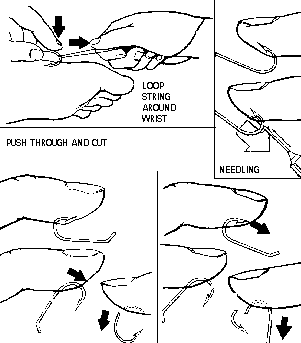10.17 Fishhook Removal
agk’s Library of Common Simple Emergencies
Presentation
The patient has been snagged with a fishhook and arrives with it embedded in his skin.
What to do:
- Cleanse the hook and puncture wound with povidone-iodine or another antibiotic solution. Provide tetanus prophylaxis as needed. Most patients will benefit from local infiltration of 1% buffered lidocaine using a 27 gauge needle inserted through the hole created by the fishhook.
- For hooks lodged superficially, first try the simple “retrograde” technique. Push the hook back along the entrance pathway while applying gentle downward pressure on the shank (like the downward pressure in the “string” technique below). If the hook does not come out, an 18 gauge needle may be inserted into the puncture hole and used as a miniature scalpel blade. Manipulate the hook into a position so you can cut the bands of connective tissue caught over the barb and release it.
- For more deeply imbedded hooks, a more complex technique of “needling” the hook requires somewhat greater skill but also allows you to work on an unstable skin surface such as a finger or ear. Slide a large gauge (#20 or #18) hypodermic needle through the puncture wound alongside the hook. Now blindly slide the needle opening over the barb of the hook and, holding the hook firmly, lock the two together. Now with the barb covered, remove the hook and needle as one unit.
- When a single hook is superficially embedded in a stable skin surface such as the back, scalp or arm, a simple way to remove it is by using the “string” technique. Align the shaft of the hook so that it is parallel to skin surface. Press down on the hook with your index finger to disengage the barb. Place a loop of string (fishing line or 1-0 silk) over your wrist and around the hook, and with a quick jerk opposite from the direction the shaft of the hook is running, pop the hook out. When done properly, this procedure is painless and does not require anesthesia. The hook may shoot out in the direction that the string is being pulled, so be careful that no one is standing in the path of the fishhook.
- When the hook is deeply embedded, the barbed end of the hook is protruding through the skin, or you are unable to utilize the previous techniques, proceed with the tried and true “push through” maneuver. Locally infiltrate the area with l% buffered lidocaine and then push the point of the hook along with its barb up through the skin. Now with a pin cutter or metal snip, cut off the tip of the hook and remove the shaft or cut off the shaft of the hook and pull the tip through.
- If a multifaceted (treble) hook is embedded, cover the free hooks with corks or use a pin cutter or metal snips to remove the free hooks and protect the patient as well as yourself from additional harm. When significant manipulation is anticipated, infiltrate first with 1% buffered lidocaine.
What not to do:
- Do not try to remove a multiple hook or a fishing lure with more than one hook without first removing the free hooks or embedding them in a protective material.
- Do not attempt to use the “string” technique if the hook is near the patient’s eye.
- Do not routinely prescribe prophylactic antibiotics. Even hooks that have been contaminated by fish rarely cause secondary infection.
Discussion:
With the string, retrograde and needling techniques, there is no lengthening of the puncture track or creation of an additional puncture wound. The quickest and easiest method for removing a fishhook is the string technique. It is a technique you can use in the field because no special equipment or anesthesia is required, but it is not recommended when the hook is positioned on a skin surface that is likely to move when the string is pulled. This movement will cause the vector of force to change and therefore the barb may not release.
Illustration

-----------------------------------------------------
from Buttaravoli & Stair: COMMON SIMPLE EMERGENCIES ©
Longwood Information LLC 4822 Quebec St NW Washington DC 20016-3229
1.202.237.0971 fax 1.202.244.8393 electra@clark.net
-----------------------------------------------------

